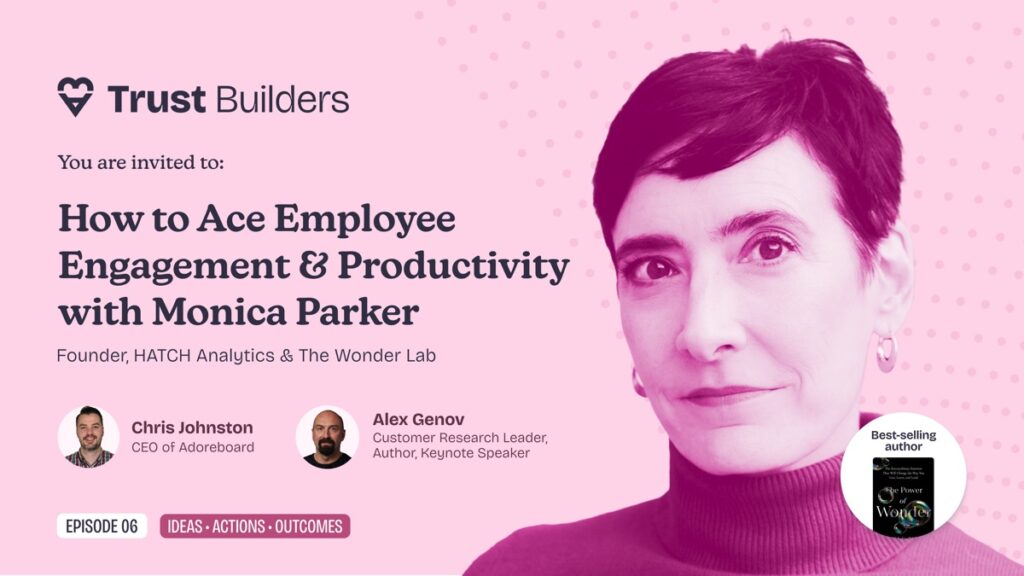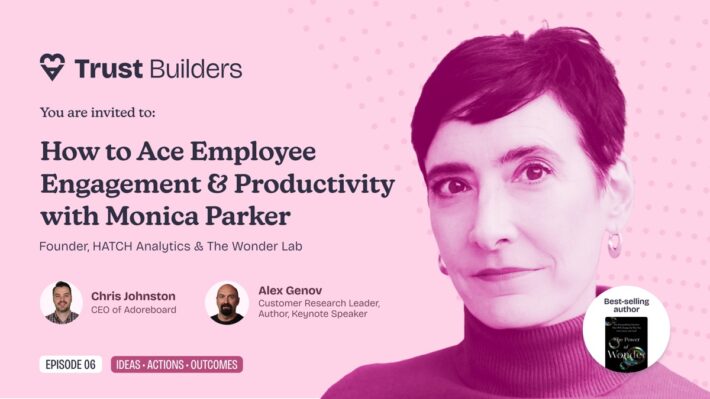Between ‘quiet quitting’ and The Great Resignation, many businesses are having a rude awakening about taking employee experience for granted. It’s no longer enough to expect employees to do whatever is asked of them with a smile in exchange for a pay check, the relationship between employee and employer needs to be just that: a relationship.
If it isn’t, your business will start haemorrhaging talent and losing your best and brightest to a rival that does value them. Employee experience (EX) is often overlooked for customer experience (CX) for the simple reason of believing that since one group actively gives a business money, that’s who you need to care about.
However, there is more than enough evidence out there to show that the two are linked and one of the best ways to improve CX, is to start with EX. Happy employees provide better service so give a better customer experience. Pretty simple trend!
So, where to start when looking to improve your employee experience? Adoreboard are experts in putting employee and customer emotions at the forefront of corporate strategy, so we’ve seen it all. Here are some lessons we’ve learned to help keep everyone around the business happy.
Embrace bottom-up decision making
We’re not talking about downing your drink, save that for after work. A ‘bottom-up’ approach is an employee-centric management style where decisions start from lower down a traditional hierarchy. Gather feedback from the employees closest to the customers, the ones that the higher-ups wouldn’t traditionally have an open dialogue with and hear what they think would make them more efficient and happy in their jobs.
Try not to make decisions on behalf of employees without keeping them at the heart of the process, they know the ins and outs of their role better than anyone – trust the experts. A bottom-up approach helps create a culture of collaboration around a business and makes people feel trusted. This increases motivation and can lead to innovation through idea-sharing and empowerment.
Keep listening to your employees
89% of businesses assume that employees that leave do so for a higher salary. However, only 12% of people earn more at their next job. There’s more to people’s lives than money, there are a host of reasons people are dissatisfied with their current situation and look elsewhere. The only way you’ll know why people leave is through listening to them. Encourage real-time and closed-loop feedback – this isn’t just for customers! Anything from a suggestion box to regular online surveys are a great way to keep on top of understanding what solutions employees require and show that you value their opinions as individuals.
Keep listening to reduce staff turnover by getting a better understanding of what drives job satisfaction on an individual level.
Predict your drivers of EX with Adoreboard
It’s all well and good listening to your employees and gathering all that data, but unless you do something with it, it’s just sitting there looking all unstructured and sad. That’s where Adoreboard comes in.
The platform takes all that text you’ve gathered from communication with employees and surveys, and organises it into themes or drivers. These can be anything notably mentioned, such as ‘onboarding’, ‘training’, ‘management’, ‘benefits’, ‘office temperature’, etc. It then tells you what percentage of people are mentioning that driver along with how they feel about it.
They might express joy, in which case you’re all good, keep doing what you’re doing – or disgust, in which case let’s work on that. There’s a whole spectrum of emotions to work with and use to tailor your approach from a granular level. From there we predict which drivers will best improve your overall EX if actioned on in a specific way.
Give employees the ability to set personalised goals and support them
Supporting someone in their professional development is as important to your business goals as it is to their personal ones. 94% of recently departed employees surveyed said they would have stayed if their former employer made a greater investment in workforce education.
There’s a difference between performance and development goals, with both feeding directly into an employee’s experience working at your company and both benefiting from listening directly to individuals. Nobody knows the nature of a role like the employee, so they’ll have a different insight into what success looks like, especially in dynamic industries. Don’t assume that management know what a top performance should be as you risk stagnating and relying on outdated metrics while competitors look to the future.
Supporting employees with personal development goals is a bit of an open goal for EX. Don’t forget the basics, people like feeling supported and encouraged to grow as professionals. Everyone is different and most people always have an eye on moving up and becoming better. If you identify education and development goals alongside employees, helping them learn new skills and gain experiences that matter to them, they can bring these to their work instead of looking for the opportunity elsewhere. This brings us neatly on to…
Cultivate trust in leadership
Employees invest so much of their own time, energy, and resource into their work that it’s so important that they feel invested in themselves. They need to feel that you’re continually investing in them while managing in an honest, transparent, and inspiring way. Constant, respectful, and genuine communication between the lines of a hierarchy are essential to getting everyone onside and singing from the same song sheet.
People respect respectful people, so be sure to follow through on your commitment to your employees and demonstrate fairness. Especially when it comes to growth opportunities, everyone should be given equal treatment.
Little things like acting with self-awareness and showing vulnerability go a long way to cultivating trust in leadership. It isn’t always easy, especially in the workplace, to be a more authentic version of yourself but if those higher up the pyramid acknowledge their failures and encourage dialogue, they’re seen as more approachable and less arrogant.
Make sure you’re using the right tools for your employees
It’s the 21st century – we’ve lost track of just how many tools and types of software are out there to help us get work done. In a week something might come out making most of them obsolete, it’s an ever-changing consideration in the workplace. As management or someone who decides what’s used at work, it can be easy to fall into the trap of assuming that what works for you, works best for everyone else – even if most people in the company have radically different day-to-day tasks to do.
This is where gauging the emotions of your employees and looking at bottom-up decision making can be so important. We’re not saying you give everyone a license to whatever system they want, but take into account the different needs and experiences of teams and individuals. If something isn’t working, is hard to onboard new recruits to, or is causing distress just to use day-to-day, evaluate whether it’s worth sticking with just for the sake of it.
Employee experience, why you should care, and how you can build
It doesn’t hurt to treat people with respect and obviously we all would rather be as happy as possible in our work. But EX goes well beyond having people logging on with a song in their heart; it has massive implications for how your business operates and ultimately succeeds. It’s more than a people problem, it’s a strategic business consideration.
Like any such opportunity, you’re going to want to approach improving it with maximum ROI in mind. Use existing data and information from your employees and transform it into an actionable plan to increase EX in a matter of seconds using the Adoreboard platform. Your employees want a better experience- who wouldn’t? Take their own words and work with Adoreboard to immediately predict which actions on which specific areas in your business would have the biggest impact on EX and build from there. A better experience for employees historically translates to a better experience for your customers – and that means more profit for your business.







